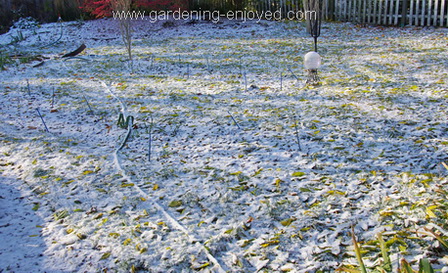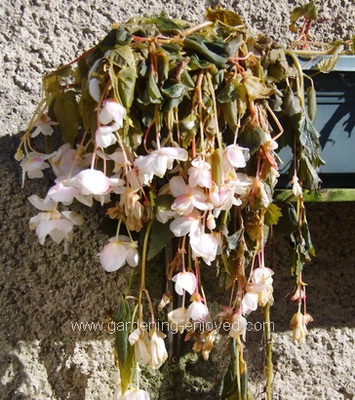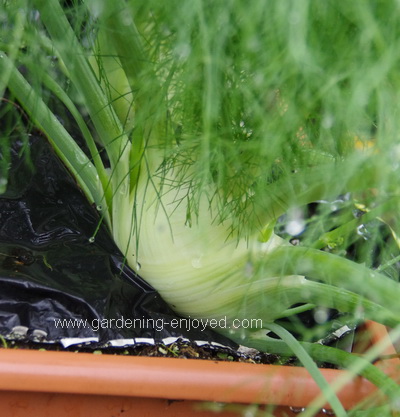
Mother Nature really likes to challenge me or maybe it’s the other way around and that’s why I continue to face challenges. The great garden renovation was essentially completed last week and on Wednesday two skids of sod arrived. Brian, my neighbour who is trying out for the “neighbour of the year award” helped me lay 1000 sq.ft. of sod in about 4 hours. I was able to water most of it on Thursday and had the hose and sprinkler set up in the final position for Friday morning when we awoke to find this lovely carpet of white and a temperature well below freezing. We had to be out of town all weekend and I will be going out shortly, to continue the watering. No matter what time of year that you lay sod, water is the key to a successful job. Those hundreds of little grass plants are struggling to survive with whatever roots they have been left with in that thin layer of soil. We need to water often and deep to keep them alive and to encourage them to find moist soil to
sink their roots into. Of course I erred on the positive side and am now trying to figure out what to do with the 100 sq. ft. of sod that is still sitting in the driveway. Very expensive compost. Maybe that small garden at the back that is always too wet can be eliminated and sodded. That’s just another day or so of abusing my body.
 I spent some time last Thursday preparing for the predicted -9C (16 F) overnight. All of the automatic watering system in the vegetable sub irrigation boxes was removed and the hoses drained. There is now much more to be done. Along with the snow on Friday morning there was a garden filled with mushy black plants and I will be rescuing Begonia tubers from their containers and digging up Dahlia Tubers wherever I find a pile of black mush hanging from the wire supports. Even the cool weather vegetables are looking a little worse for wear. They like “cool” weather but apparently -9 C is beyond their definition of “cool”. There also seems to be a box of bulbs on the front porch that I don’t seem to have planted as yet. Hopefully the deep freeze didn’t affect them.
I spent some time last Thursday preparing for the predicted -9C (16 F) overnight. All of the automatic watering system in the vegetable sub irrigation boxes was removed and the hoses drained. There is now much more to be done. Along with the snow on Friday morning there was a garden filled with mushy black plants and I will be rescuing Begonia tubers from their containers and digging up Dahlia Tubers wherever I find a pile of black mush hanging from the wire supports. Even the cool weather vegetables are looking a little worse for wear. They like “cool” weather but apparently -9 C is beyond their definition of “cool”. There also seems to be a box of bulbs on the front porch that I don’t seem to have planted as yet. Hopefully the deep freeze didn’t affect them.
 I did some harvesting of vegetables that I thought might be affected by that freeze and this is one of a few delightful Fennel that we managed to produce in those containers this fall. It is a wonderful vegetable. Fresh and crisp with a pleasant licorice flavour whether it is eaten raw as a treat, chopped into a salad or combined in a vegetable stir fry. I have had varying degrees of success trying to grow it for many years and seemed to have found the answer. Seed it in late July, transplant to the sub irrigation containers at the end of August and enjoy it throughout the fall. Getting it to form those basal bulbs is the real indicator of success. Delicious!
I did some harvesting of vegetables that I thought might be affected by that freeze and this is one of a few delightful Fennel that we managed to produce in those containers this fall. It is a wonderful vegetable. Fresh and crisp with a pleasant licorice flavour whether it is eaten raw as a treat, chopped into a salad or combined in a vegetable stir fry. I have had varying degrees of success trying to grow it for many years and seemed to have found the answer. Seed it in late July, transplant to the sub irrigation containers at the end of August and enjoy it throughout the fall. Getting it to form those basal bulbs is the real indicator of success. Delicious!
Now it’s time to answer a few of my reader’s questions. To ask a question just “reply” to this ezine. Don’t forget to check the front page of the Website for frequent short ideas for current gardening activities.
Eileen Asks? Thank you for all the wonderful pictures and knowledge you put into your articles . I have a Hibiscus plant . It had flowered twice for me this season . Both times it bloomed it had tons of tiny white bugs on them . I thought It might be pollen from the flowers but now think it is an infestation of some sort . The plant is healthy and growing .I was wondering if there is a way to get rid of these pest or do I have to get rid of the Plant ?
Ken Answers! It sounds as if the white bugs are actually on the flowers and that would probably make them aphids. Hibiscus also like to play host to Whitefly but they are easily identified because they will fly away if disturbed. Both are susceptible to spraying with insecticidal soap but the trick is to do it every 2-3 days in order to catch the just hatched eggs before they can mature and lay the next batch. If you are dealing with Whitefly it's better to spray when they are sleeping but
of course it's dark then and the spraying is a bit more difficult.
Margaret Asks? Ken, that is the most luxuriant display of heavenly blue morning glories that I have ever seen. Thank you, thank you. I'm inspired to try to copy you. It has been a good year, but the most I got at one time was 15 blooms all from three different trellises. When you planted them were they in individual pots or clumped together in a larger container? Did you grow them yourself or buy them, and if so where?If you grew them from seed kindly tell me which company. They are my favourite blue flower. Thank you so much for any tips. I believe that they like poor soil.
Ken Answers! Heavenly Blue was heavenly this fall. I start my own from seed, grow them on in individual cell paks but only for a very few weeks, otherwise they get so tangled around each other it's almost impossible to separate them. They are then planted directly into the garden and NOT fertilized
because they do like poor soil. Two years ago I put the trellis in the rich soil of the vegetable garden and the vegetative growth was so profuse it broke the trellis but provided very few flowers. I've used seed from a variety of places but frequently from Renees.
|

 I spent some time last Thursday preparing for the predicted -9C (16 F) overnight. All of the automatic watering system in the vegetable sub irrigation boxes was removed and the hoses drained. There is now much more to be done. Along with the snow on Friday morning there was a garden filled with mushy black plants and I will be rescuing Begonia tubers from their containers and digging up Dahlia Tubers wherever I find a pile of black mush hanging from the wire supports. Even the cool weather vegetables are looking a little worse for wear. They like “cool” weather but apparently -9 C is beyond their definition of “cool”. There also seems to be a box of bulbs on the front porch that I don’t seem to have planted as yet. Hopefully the deep freeze didn’t affect them.
I spent some time last Thursday preparing for the predicted -9C (16 F) overnight. All of the automatic watering system in the vegetable sub irrigation boxes was removed and the hoses drained. There is now much more to be done. Along with the snow on Friday morning there was a garden filled with mushy black plants and I will be rescuing Begonia tubers from their containers and digging up Dahlia Tubers wherever I find a pile of black mush hanging from the wire supports. Even the cool weather vegetables are looking a little worse for wear. They like “cool” weather but apparently -9 C is beyond their definition of “cool”. There also seems to be a box of bulbs on the front porch that I don’t seem to have planted as yet. Hopefully the deep freeze didn’t affect them. I did some harvesting of vegetables that I thought might be affected by that freeze and this is one of a few delightful Fennel that we managed to produce in those containers this fall. It is a wonderful vegetable. Fresh and crisp with a pleasant licorice flavour whether it is eaten raw as a treat, chopped into a salad or combined in a vegetable stir fry. I have had varying degrees of success trying to grow it for many years and seemed to have found the answer. Seed it in late July, transplant to the sub irrigation containers at the end of August and enjoy it throughout the fall. Getting it to form those basal bulbs is the real indicator of success. Delicious!
I did some harvesting of vegetables that I thought might be affected by that freeze and this is one of a few delightful Fennel that we managed to produce in those containers this fall. It is a wonderful vegetable. Fresh and crisp with a pleasant licorice flavour whether it is eaten raw as a treat, chopped into a salad or combined in a vegetable stir fry. I have had varying degrees of success trying to grow it for many years and seemed to have found the answer. Seed it in late July, transplant to the sub irrigation containers at the end of August and enjoy it throughout the fall. Getting it to form those basal bulbs is the real indicator of success. Delicious!